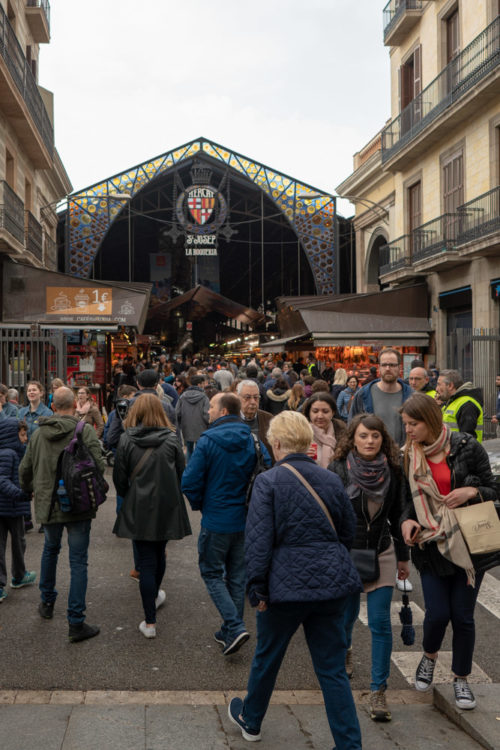
For our second day in Barcelona, we wanted to explore Gothic Quarter (Barri Gòtic) which is the centre of the old city of Barcelona. We took the metro from Diagonal metro station closest to our hostel and within 2 stops reached Liceu (Green Line, L3). Coming out of the metro station we were greeted by the majestic entrance of La Boqueria market. La Boqueria is a famous market located in El Raval with an entrance to the market from La Rambla. It provides a wide variety of fresh fruit, vegetables, nuts and seeds, sweets as well as meat, fish, cheese, and dairy. However, even if you’re not looking to buy anything at the market it is well worth a visit just to soak up the atmosphere and the explosion of colours from the fresh fruits in the stalls.
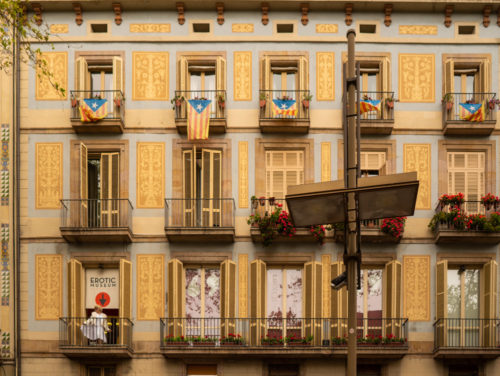
Conceived as an informative, as well as curious and fun museum, the Erotic Museum of Barcelona shows us how Erotica has evolved from the beginnings of civilization until the present day, focusing on different cultures and eras. Situated just in front of the La Boqueria Market, on the Rambla de Barcelona, its central location is a real attraction for all the tourists who walk along La Rambla each day, although the museum is aimed just as much towards the city’s locals as towards tourists. No, we did not visit it, as we know better. Thanks to Kamasutra & Khujaraho 😉
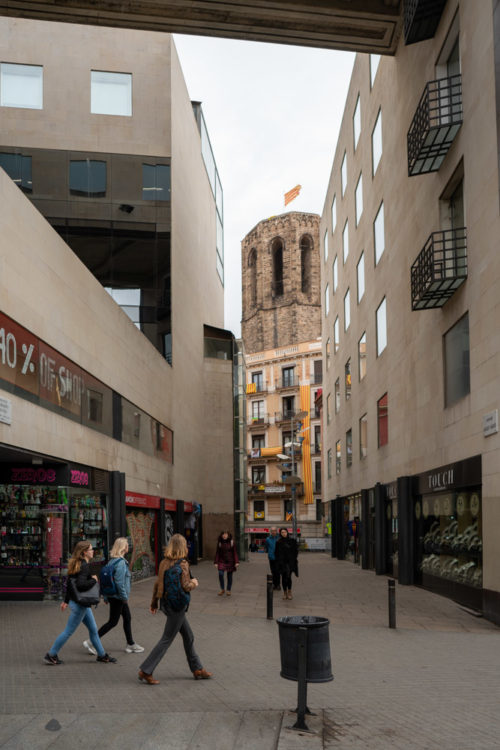
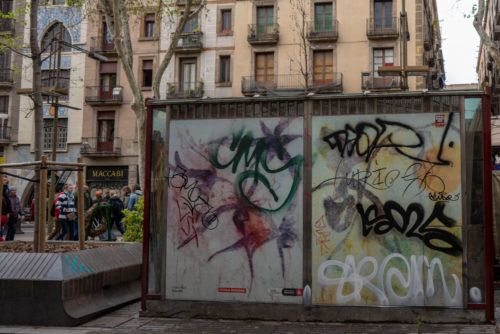
Despite its name, several landmark Gothic buildings in the neighbourhood do not date to the Middle Ages. Rather, in the late 19th and early 20th centuries, the quarter was completely transformed from a sombre neighbourhood to a tourist attraction through a massive restoration project, timed to be completed for the 1929 International Exhibition. Further restoration of existing buildings and the creation of brand new neo-Gothic structures continued as late as the 1960s.
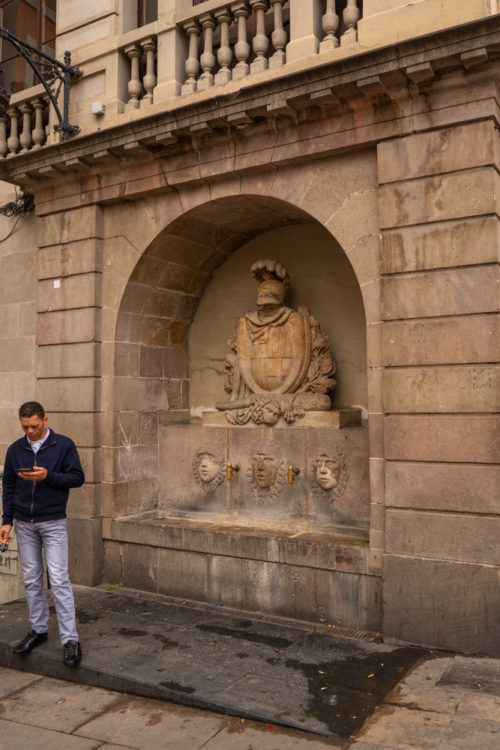
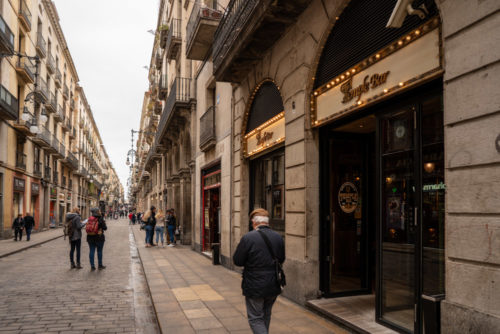
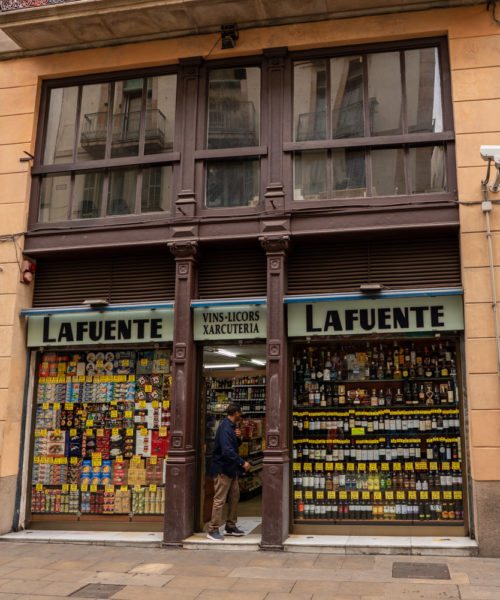
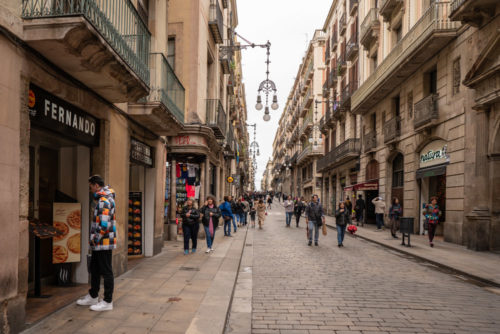
Since we wanted a guided tour, we opted for Sandeman’s tour. They have a concept called a free walking tour. The tour takes 2-2.5hours. You pay in cash what you believe the tour was worth at the end of the tour to your tour guide who are volunteers who make money by showing you around. This ensures volunteers really strive hard to make your experience as great as possible, which makes you pay him 🙂 That is the incentive for the guide as well as tourists. If you are not satisfied, you don’t have to pay or can walk off.
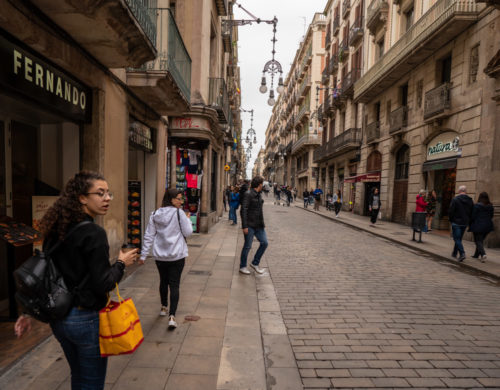
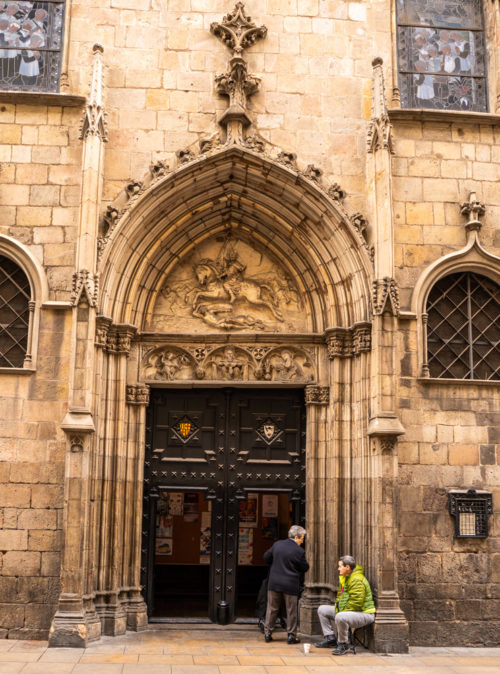
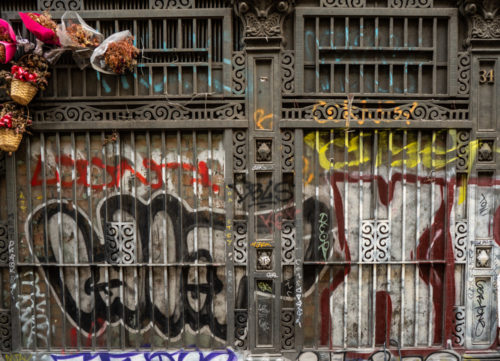
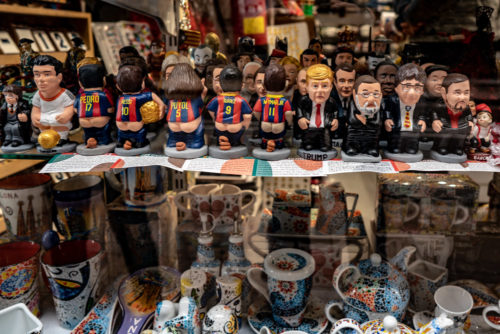
The tour started at Jaume Metro station Exit at around 12 PM. It was drizzling slightly. Onno was our great tour guide. We found out so much about Barcelona, Catalonia and the Spanish culture we would have otherwise not known from this very lively guide. You can see him at the left corner of the photo below.
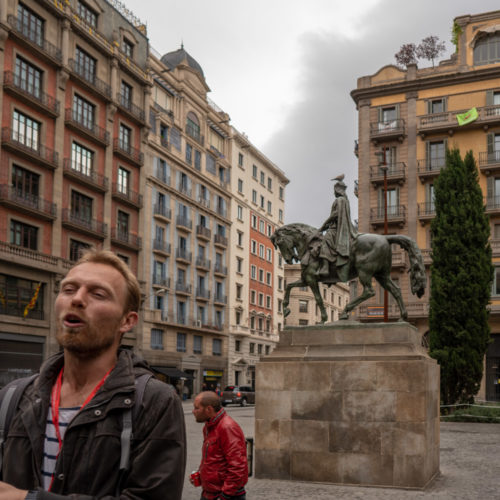
We started our tour from the Statue of Ramon Berenguer III. This life-size bronze equestrian statue of Ramon Berenguer III was sculpted by Frederic Marès and inaugurated in 1950. Ramon is a hero in Catalonia because he was able to expand the territories of Catalonia, including Provence, Tarragona, Mallorca, and Ibiza. Ramon Berenguer III created alliances with the other Catalan counts and through a combination of military actions and tactical marriages, expanded his Catalan dynasty. When Pope Paschal authorized a crusade against the Moors in the Balearic Islands, it was Ramon Berenguer III who led the Christian fleets which conquered Ibiza and Mallorca in 1114 and 1115.
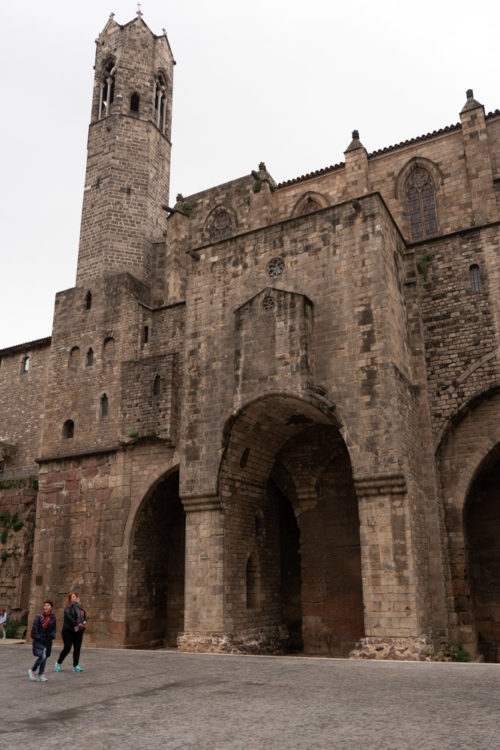
While Catalan had a closer connection with present-day France, it consciously did not want to be part of the present-day Spain where Moors had occupied. This fight to separate themselves as Catalans continue even today.
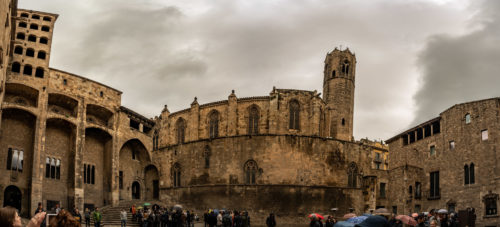
Our next stop was Plaça del Rei (King’s Square). Located in the Gothic Quarter of Barcelona. It is, arguably, the Gothic architectural ensemble which best exemplifies the city’s medieval past. The royal palace, the Palau Reial Major, and its surrounding buildings enclose a harmonious and peaceful square which is still imbued with Barcelona’s splendour during the Middle Ages.
The imposing royal palace, the Palau Reial Major, rises at the back of the Plaça del Rei in Barcelona, with the Watchtower of King Martí on one side. The palace was the residence of the Catalan counts from the 13th to the early 15th centuries, and the history of the building can be traced back to the Barcelona of the 11th century, although its current appearance is the result of alterations carried out in the 13th century. This means that the building is predominantly Gothic in style, although the base of the building features Visigothic and Romanesque elements. Inside, the Great Hall, or Saló del Tinell, with its round arches, is the most representative and beautiful room in the Palau Reial Major.
On one side of the building, on top of the old Roman wall of Barcelona, you can see the 14th-century royal chapel of Santa Àgata, which contains the valuable Contestable altarpiece by Jaume Huguet. The building opposite is the 16th-century Palau del Lloctinent, or Lieutenant’s Palace, which has a beautiful Renaissance courtyard and is currently home to the Archive of the Crown of Aragon. Closing off the Plaça del Rei is the Casa Clariana-Padellàs, the home of the city’s history museum, the Museu d’Història de la Ciutat de Barcelona, which contains the archaeological remains of Roman Barcelona.
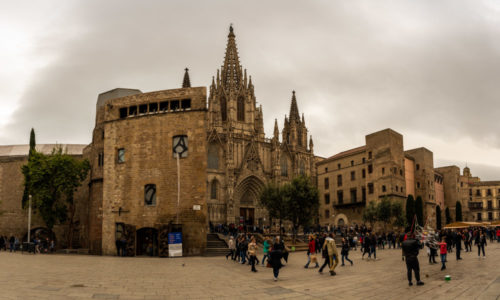
As we come out Plaça del Rei we are greeted with most prominent structure in that area – Barcelona Cathedral. Also known as The Cathedral of the Holy Cross and Saint Eulalia, is the neo-Gothic cathedral and seat of the Archbishop of Barcelona, Spain. The cathedral was constructed from the 13th to 15th centuries, with the principal work done in the 14th century. The cloister, which encloses the Well of the Geese (Font de les Oques) was completed in 1448. In the late 19th century, the neo-Gothic façade was constructed over the nondescript exterior that was common to Catalan churches. The roof is notable for its gargoyles, featuring a wide range of animals, both domestic and mythical.
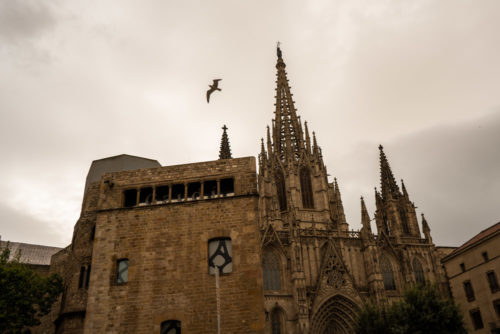
The cathedral is dedicated to Eulalia of Barcelona, co-patron saint of Barcelona, a young virgin who, according to Catholic tradition, suffered martyrdom during Roman times in the city. One story says that she was exposed naked in the public square and a miraculous snowfall in mid-spring covered her nudity. The enraged Romans put her into a barrel with knives stuck into it and rolled it down a street. The body of Saint Eulalia is entombed in the cathedral’s crypt.
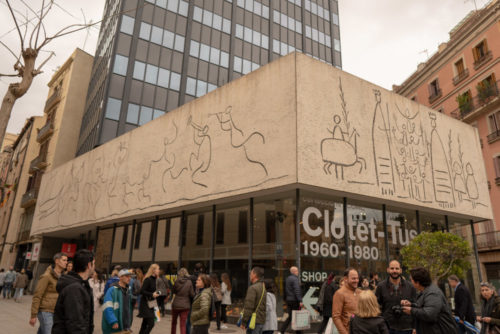
Official College of Architects of Catalonia and the Balearic Islands is in the Plaça Nova of Barcelona, in front of the Cathedral. The building is decorated three friezes by Picasso, produced by the Picasso’s chosen fabricator — the artist who turned Picasso’s drawings and scale models into large public sculptures, Nordic artist Carl Nesjar. There are three friezes. The “children’s frieze”, on the façade overlooking Carrer dels Arcs, the “giants’ frieze”, opposite Cathedral, and the “frieze of the Catalan flag”, on the façade overlooking Carrer Capellans.
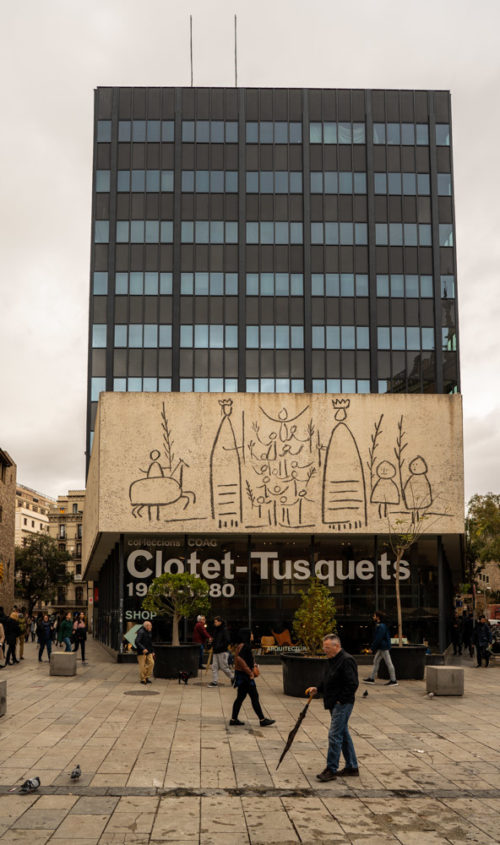
The drawings were created by sandblasting the concrete, uncovering the black stones inside the concrete. Even though it looks like a childish type of sketch by Picasso, Castells (human towers), Falcons (human buildings), Gegants (Giants), Bastoners (stick dancers), Sardanas, Moixigangas, and other traditional dances in these friezes.
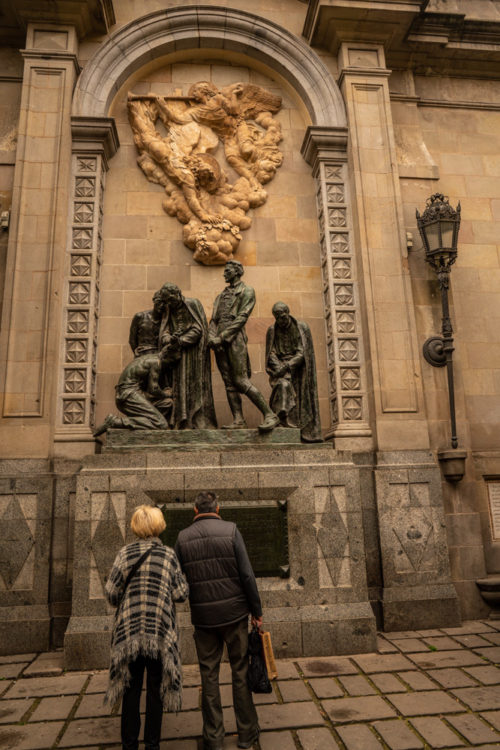
The road next to the cathedral shows the Monument to the heroes of 1809. This realist monument stands in surprising contrast to the predominant Gothic style of the surrounding buildings. It portrays five martyrs who were executed following an attempted uprising against the French troops during the occupation of Barcelona in 1809.
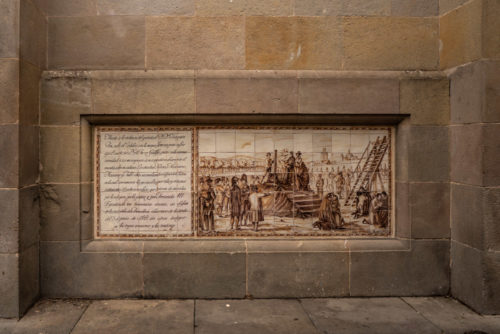
The dictatorship of Primo de Rivera culminated with the dedication of a monument to the heroes of the 1809 uprising. The year was 1929 and Josep Llimona was commissioned to create the five bronze elements that surmount the plinth. The sculptures are marked by a realism that is devoid of dramatism and shows the people who had been condemned to the garrotte, shortly before their execution at the Citadel. They were accused of attempting to free Barcelona from the French forces of occupation who had made the city their stronghold during the War of the Spanish Succession.
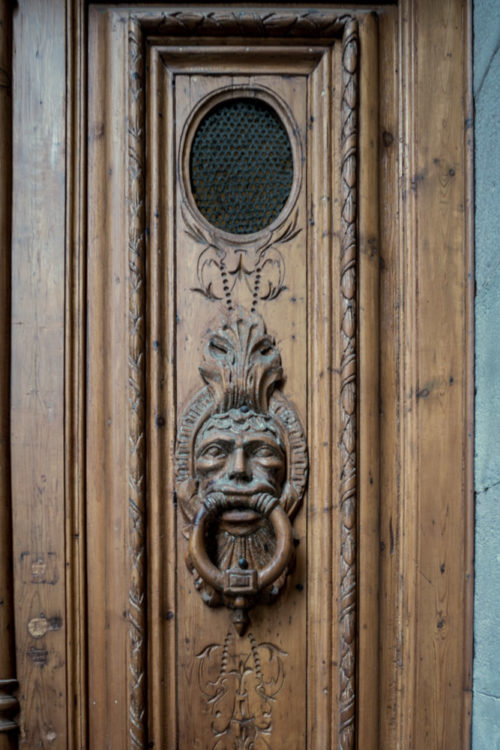
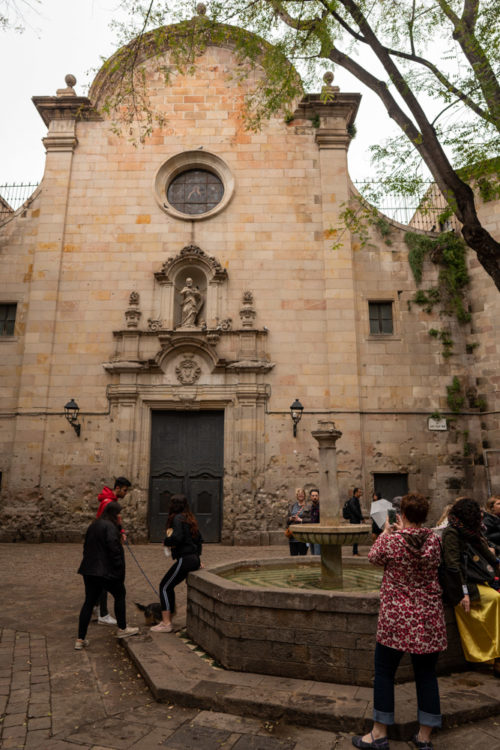
Our next stop was Plaça de Sant Felip Neri. It is a small square in the Gothic Quarter in the district of Ciutat Vella in Barcelona, Spain. The square takes its name from the Church of Saint Philip Neri which presides over the square. To the right of the church is the School of Saint Felip Neri which uses the square as a playground. To the left of the church is a house used by the Oratory of Saint Philip Neri. In the centre of the square is an octagonal fountain, dedicated as a symbol of life. The architecture of the square and surrounding buildings is in the medieval Baroque-style.
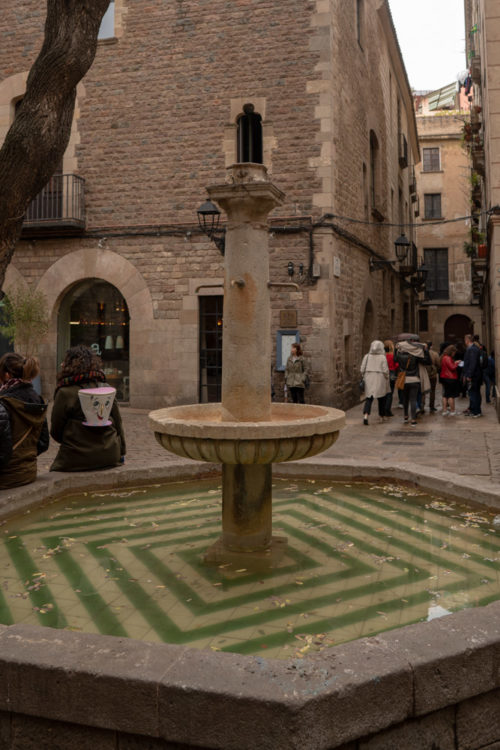
During the civil war, it was used as a home for evacuated children. On the 30th of January 1938, a bomb dropped by Franco’s air force exploded directly in front of the church killing 30 of the children who were sheltering inside. Shortly afterwards, while people were trying to rescue survivors, a second bomb exploded in the square bringing the death toll to 42. You can see the pack marks of the Bomb on the walls of the Church.
[youtube]5anLPw0Efmo[/youtube]
The square was featured in a music video by the band Evanescence, which captured the ambience of the square perfectly in her My Immortal. Check the video above.
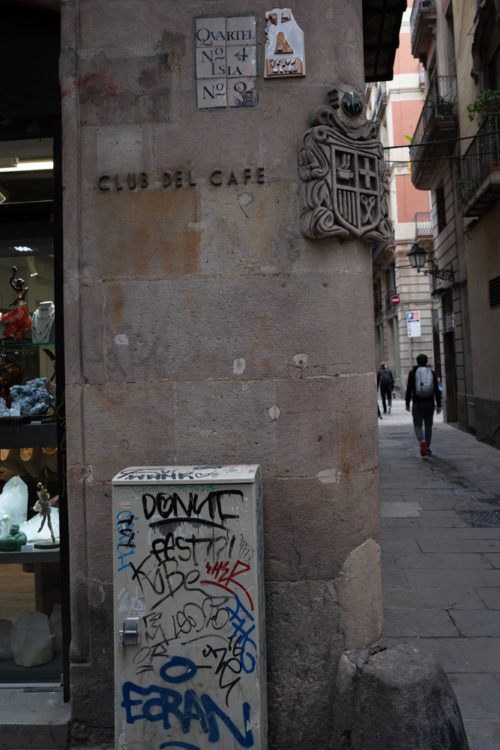
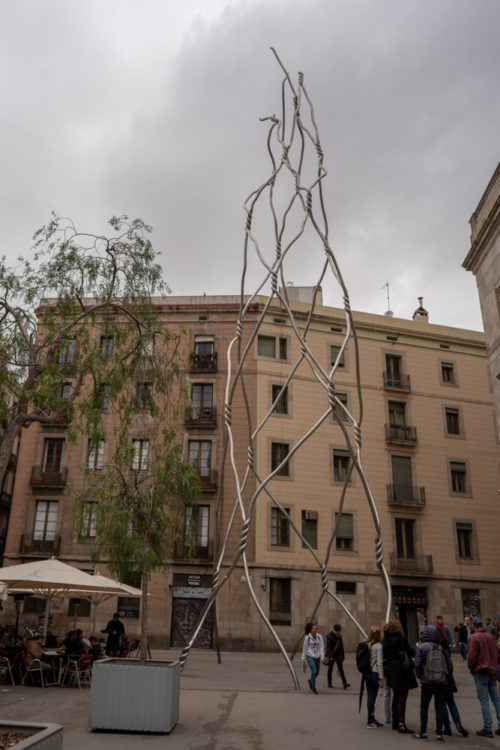
Located in Plaça de Sant Miquel behind Barcelona’s City Hall, this unusual 26.5m high stainless-steel tower by Antoni Llena i Font can be seen. The statue is titled Homenatge als Castellers and is a tribute to the emblematic human towers which are a traditional feature of public events in Catalonia. Each of the X-shaped sections of chicken wire represents a person. The tower is made up of six layers, each of which gets progressively smaller. This echoes the fact that in the real human towers the lower layers are formed by men, the middle layers by women and teenagers and the upper levels by children. The unattached tubes at the top of the sculpture recall the outstretched arm of the enxaneta or small child who tops the tower.
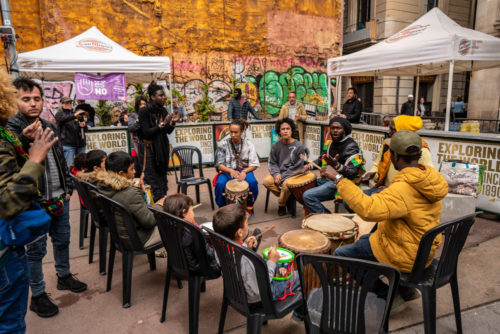
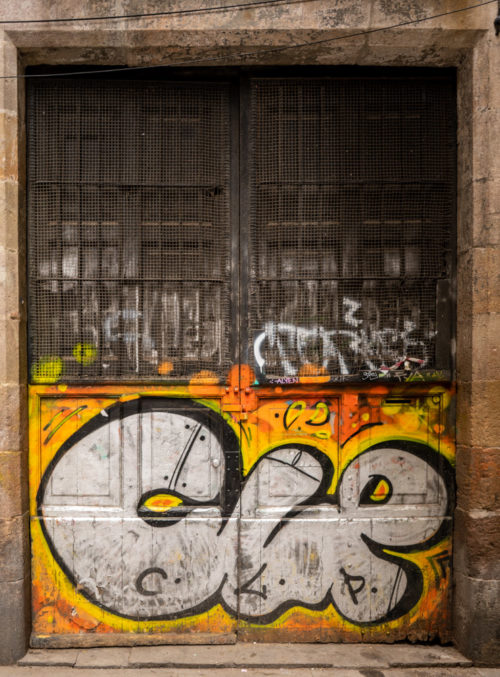
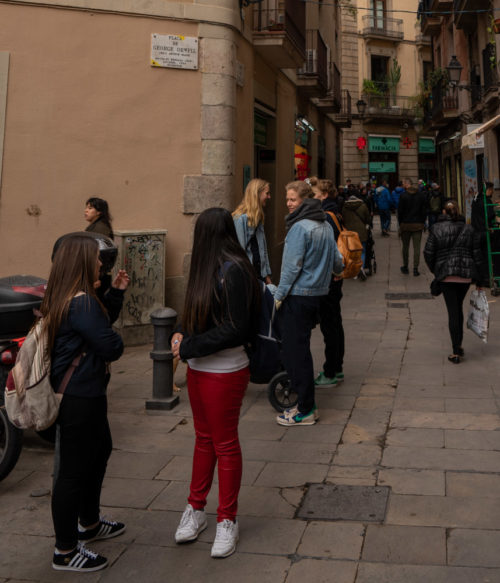
Orwell served militia in Catalonia and Aragon from December 1936 until June 1937. In June 1937, the leftist political party with whose militia he served (the POUM) was declared an illegal organisation, and Orwell was consequently forced to either flee or face imprisonment. Orwell served on the Aragon front for 115 days. It was not until the end of April 1937 that he was granted leave and was able to see his wife Eileen in Barcelona again. At the front, Orwell was shot through the throat by a sniper on 20 May 1937 and nearly killed.
He wrote his experiencesin Homage to Catalonia that people frequently told him a man who is hit through the neck and survives is the luckiest creature alive, but that he personally thought “it would be even luckier not to be hit at all.” The trial of the leaders of the POUM and of Orwell (in his absence) took place in Barcelona. Barcelona fell to Franco’s forces on 26 January 1939. The experience shook him, helping shape what would become his most famous books: Animal Farm and 1984. He and his wife stayed at the Hotel Continental, which can still be found at the top of La Rambla.
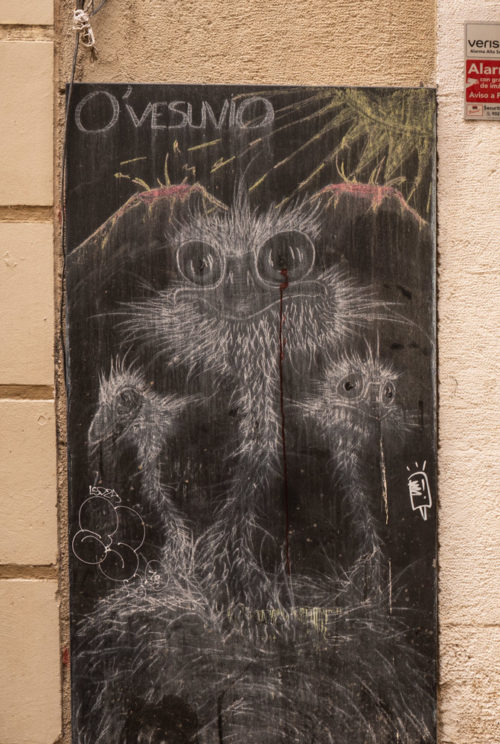
Describing Gaudi’s towering Sagrada Familia cathedral, still under construction, in his book Homage to Catalonia, he writes: ‘A modern cathedral and one of the most hideous buildings in the world… I think the Anarchists showed bad taste in not blowing it up when they had the chance, though they did hang a red and black banner between its spires.’
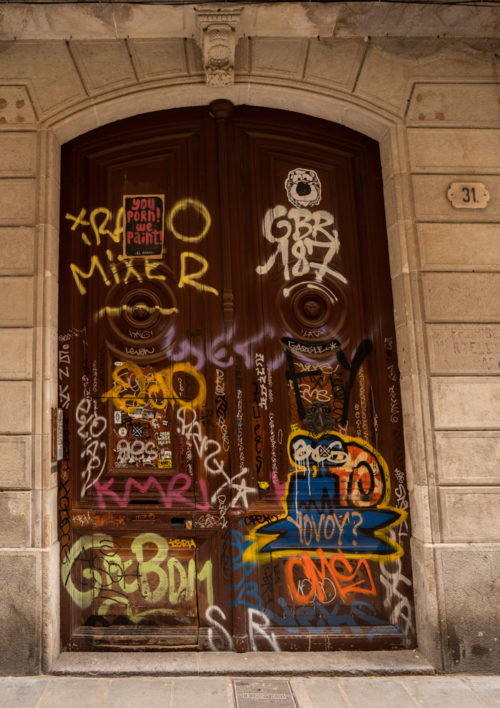
The Anarchist flag is long gone, replaced by cranes and scaffolding as the city races to finish this gleaming example of ‘modern Catalonia’. I can’t help but think that in their rush to become a European capital and wipe away the horrors of the past Barcelona is doing itself a disservice. No amount of building or modernisation will crush the revolutionary ardour which is still so palpable throughout the city in the form of banners, grafitti and revolutionary slogans.
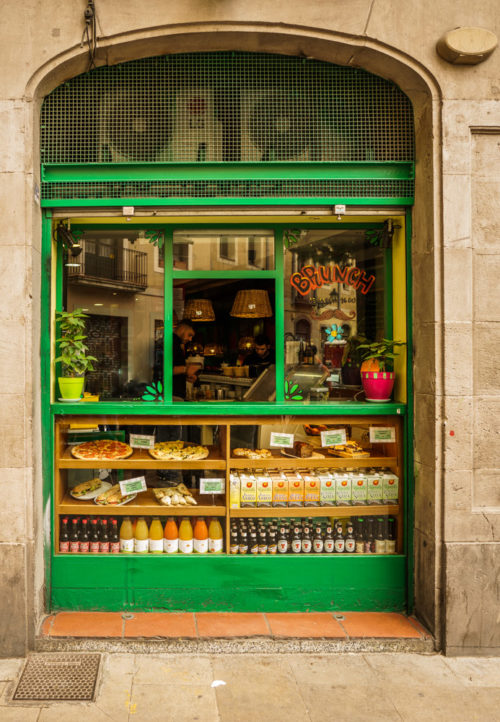
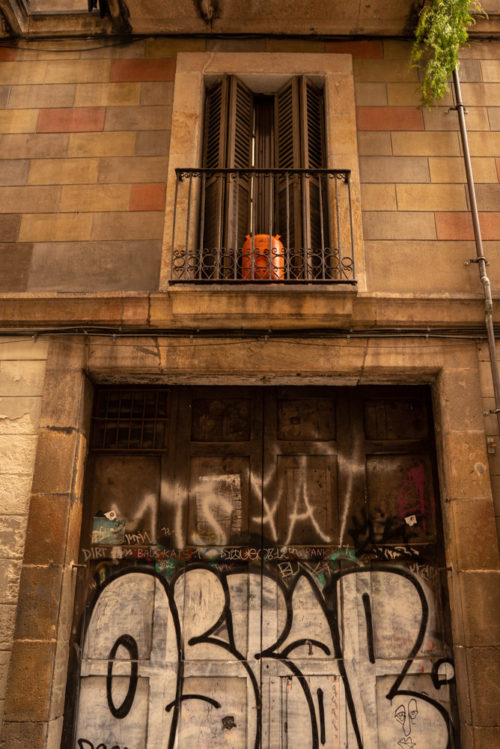
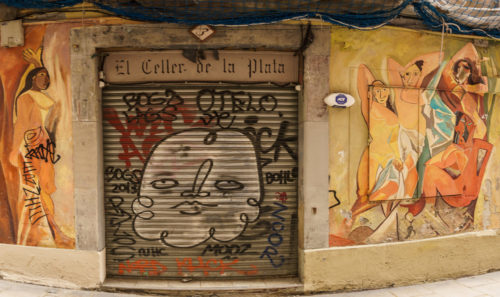
In 1895 the family Ruíz-Picasso moved to Barcelona and initially settled in where now the restaurant 7 Portes is located, on the edge of fishing district La Barceloneta. His father, who taught at the art academy La Llotja, but always had the dream to live as an artist himself, recognized the great talent of his son at an early age. Pablo was admitted to the academy at the age of fourteen but would never complete his studies. A year later, the family moved to the Carré de la Mercè in the Gothic Quarter. In its side street, Carrer de la Plata, as a tribute to Picasso, some street artist has drawn a replica of the famous Picasso Les Demoiselles d’Avignon painting. At this place, the artist had his first studio, together with Manuel Pallarés. This version is split into two parts. The Iberian hair girl on the left is on a different panel and four others seem to be on the right panel.

In 1904, Picasso left for Paris. But he would still regularly come to Barcelona, the city that he loved very much. In Paris, Picasso visits the Ethnology museum and is deeply impressed by primitive African masks and totem figures. He begins experimenting with his own art and this leads to one of his most famous works Les Demoiselles d’Avignon, he made it in the autumn of 1906. Les Demoiselles d’Avignon painting heralded a new style of painting: Cubism. The central theme was prostitution (in the Carrer d’Avinyó near his first studio, it was swarming with brothels). The painting anticipates cubism, an innovative style that he developed together with artist Georges Braque. Characteristic of cubism, for example, is the fragmentation of the image and the coming together of different viewpoints. It also had a tighter and stricter character with thick layers of paint over each other.
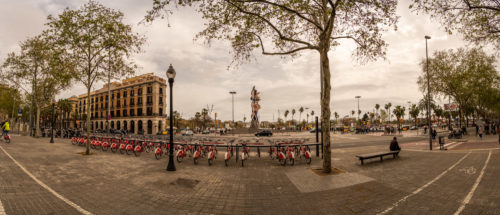
Walking further we reached close to the Barcelona harbour. El Cap de Barcelona is a surrealist sculpture created by American Pop artist Roy Lichtenstein for the 1992 Summer Olympics in Barcelona. The sculpture stands tall on the waterfront in the heart of the city. Made from concrete and ceramic, it is an abstract rendition of a woman’s head and appears exactly how one would expect a Lichtenstein sculpture to be. Although it is very abstract, the sculpture was made to resemble the head and face of a woman. It is made up of thick pieces of concrete completely covered in red, yellow, blue, black and white mosaic tiles, and from far away it looks like it could be a painting.
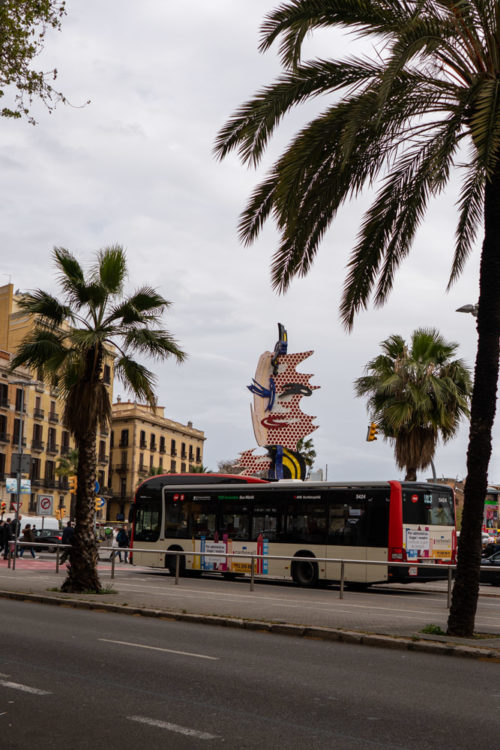
The woman’s eyes look like thick blue and black brush strokes; same with her nose, and her lips look like Lichtenstein could have used a quick stroke of bright red paint. The left third of her face, the side with the blue nose and eye, is covered with white tiles, while the right two-thirds of her face is covered in a grid of red dots, typical of Lichtenstein’s pop-art style. Lichtenstein added other artistic elements to this sculpture as well. Below her head, what would probably be considered the woman’s neck, is a tall, flat stroke of blue and white that extends all the way up through her face and ends a few inches above her head. Perpendicular to the blue and white stroke is a stroke of yellow and black, beginning at the bottom and then reappearing at the top of her head. The Head of Barcelona was built to resemble the style of Antoni Gaudi, a Catalan architect who is famous for employing organic lines and mosaic tiles throughout his architecture, and for which Barcelona is known.
Last part of the trip was along Passeig de Colom, the avenue which runs from the Christopher Columbus monument towards the Parc de la Ciutadela, is flanked by a series of elegant buildings dating back to the late 19th and early 20th centuries.
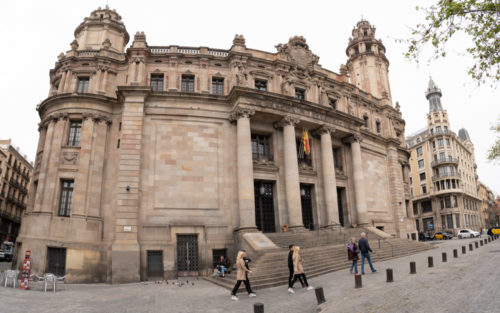
One of the most interesting of them is the Central Post Office which was designed by Josep Goday I Casals and Jaume Torres I Grau and built-in 1927. The building’s design is a mixture of Catalan Modernism and Noucentism (the architectural and artistic style which immediately followed Modernism). The post office overlooks Barcelona harbour and its façade is dominated by the classically styled main entrance. An elegant stone staircase leads up to 3 large doorways flanked by 4 Ionic style columns topped by an architrave supporting 4 statues above which there is a large coat of arms.
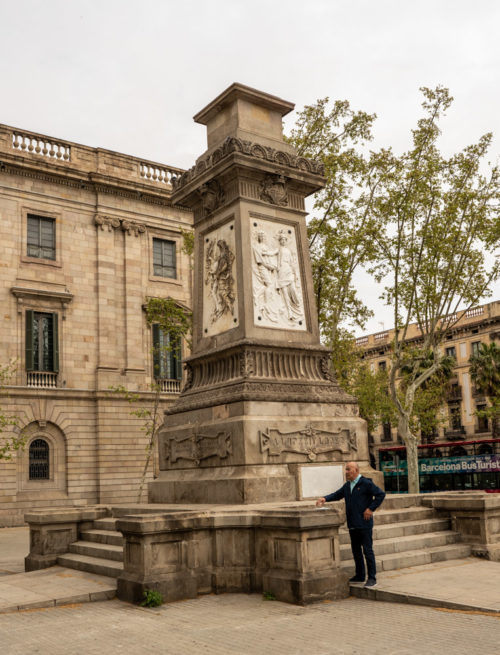
Antonio López was a Spanish businessman and shipping magnate. He was the founder of several important Spanish companies. In Barcelona, there is a monument dedicated to him and the companies he founded. Located opposite the Central Post Office, the monument was erected in 1884. The monument was destroyed in 1936 but was restored in 1944 by Frederic Marès. On March 4, 2018, the monument was finally removed after a campaign denouncing the involvement of Antonio López in the slave trade.
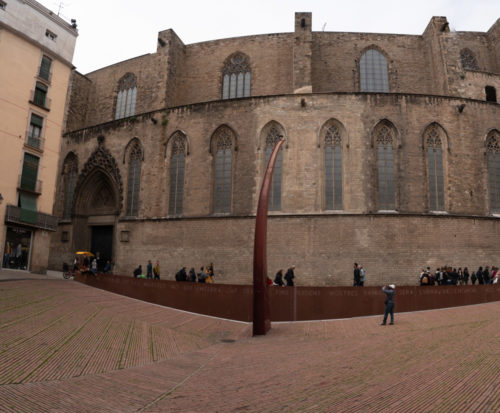
The Fossar de les Moreres literally Grave of the Mulberries is a memorial square in Barcelona adjacent to the Basilica of Santa Maria del Mar. The plaza was built over a cemetery where defenders of the city were buried following the Siege of Barcelona at the end of the War of the Spanish Succession in 1714. The plaza retains its everyday use as a public space, but also prominently features a memorial to the fallen Catalans of the war, with a torch of eternal flame and a heroic poem by Frederic Soler, “El Fossar de les Moreres“.
Given this tumultuous history connected with the decrees and the war, the Fossar de les Moreres is an important place of remembrance every year during the National Day of Catalonia, 11 September, and some Catalans yearly pay homage to the defenders of city who were killed and are buried at the memorial. The original cemetery in which Barcelona’s defenders were buried was paved over, and the square was created during the urbanization of parochial cemeteries in 1821 under pressure from King Charles III of Spain and General Castaños.
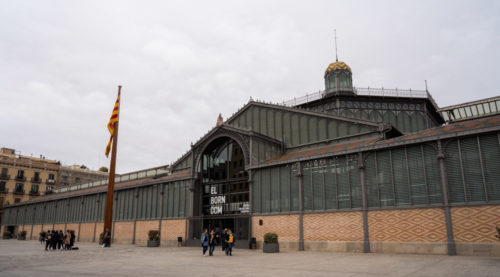
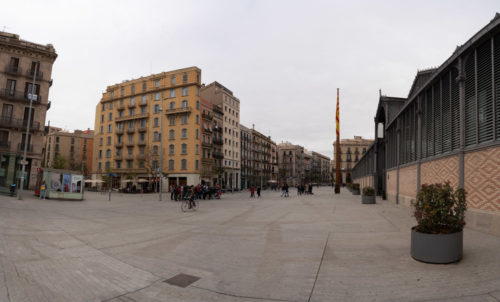
Our free tour ended at El Born Centre de Cultura i Memòria. El Born CCM is housed in a building that was formerly El Born market, which opened in 1876. The building forms part of other architectural interventions dating from a historical period in which Barcelona was immersed in the European modernist movement.
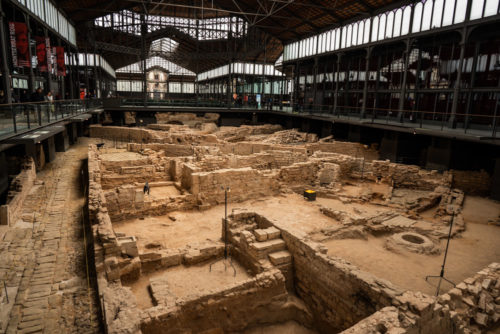
An archaeological site was found in the subsoil, revealing traces of the demarcations of streets and houses Barcelona of the 1700s, serving as a testament both to life in the city and the consequences of the siege of 1714.
Since it is getting too long for a single blog, please check the next part of this Barcelona Travel blog.


ಆರ್ವೆಲ್, ಪಿಕಾಸೋಗಳನ್ನು ಹಾಯ್ದು ಕೊಲಂಬಸ್ಸನ ಯಾತ್ರಾ ಸ್ಥಳದವರೆಗೂ ಭಯಂಕರ ಗಂಭೀರವಾಗಿಯೇ ನಡೆಸಿದ್ದೀರಿ. ನನಗಿದು ಓವರ್ ಡೋಸ್ ಆಗಿ, ಮಾರುಕಟ್ಟೆ ನವೀಕರಣಕ್ಕೆ ಹೊರಟು ೧೭೦೦ರ ಬಾರ್ಸಿಲೋನಾದ ಐತಿಹಾಸಿಕ ಹಿಂದಕ್ಕೆ ಹೋದಂತೆ ಆಗಿದೆ 🙁 ತಪ್ಪು ನಿಮ್ಮದಲ್ಲ, ನನ್ನದು. ನಿಮ್ಮ ವೈಯಕ್ತಿಕ ತರ್ಲೆ, ತಾಪತ್ರಯ, ಹಾಸ್ಯದ ಒಂದೆರಡು ಎಳೆಯಾದರೂ ಇದ್ದಿದ್ದರೆ…ರೆ… 🙂